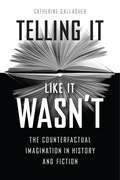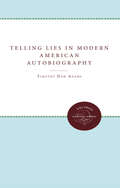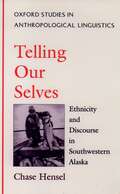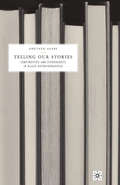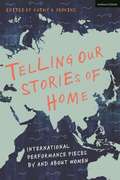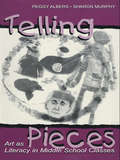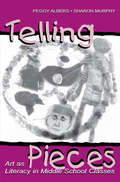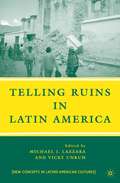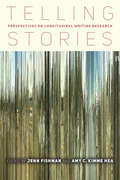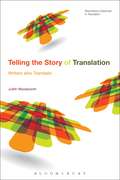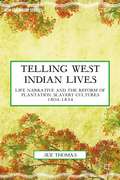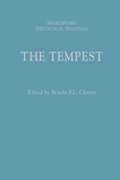- Table View
- List View
Telling It Like It Wasn’t: The Counterfactual Imagination in History and Fiction
by Catherine GallagherInventing counterfactual histories is a common pastime of modern day historians, both amateur and professional. We speculate about an America ruled by Jefferson Davis, a Europe that never threw off Hitler, or a second term for JFK. These narratives are often written off as politically inspired fantasy or as pop culture fodder, but in Telling It Like It Wasn’t, Catherine Gallagher takes the history of counterfactual history seriously, pinning it down as an object of dispassionate study. She doesn’t take a moral or normative stand on the practice, but focuses her attention on how it works and to what ends—a quest that takes readers on a fascinating tour of literary and historical criticism. Gallagher locates the origins of contemporary counterfactual history in eighteenth-century Europe, where the idea of other possible historical worlds first took hold in philosophical disputes about Providence before being repurposed by military theorists as a tool for improving the art of war. In the next century, counterfactualism became a legal device for deciding liability, and lengthy alternate-history fictions appeared, illustrating struggles for historical justice. These early motivations—for philosophical understanding, military improvement, and historical justice—are still evident today in our fondness for counterfactual tales. Alternate histories of the Civil War and WWII abound, but here, Gallagher shows how the counterfactual habit of replaying the recent past often shapes our understanding of the actual events themselves. The counterfactual mode lets us continue to envision our future by reconsidering the range of previous alternatives. Throughout this engaging and eye-opening book, Gallagher encourages readers to ask important questions about our obsession with counterfactual history and the roots of our tendency to ask “What if…?”
Telling It Like It Wasn’t: The Counterfactual Imagination in History and Fiction
by Catherine GallagherInventing counterfactual histories is a common pastime of modern day historians, both amateur and professional. We speculate about an America ruled by Jefferson Davis, a Europe that never threw off Hitler, or a second term for JFK. These narratives are often written off as politically inspired fantasy or as pop culture fodder, but in Telling It Like It Wasn’t, Catherine Gallagher takes the history of counterfactual history seriously, pinning it down as an object of dispassionate study. She doesn’t take a moral or normative stand on the practice, but focuses her attention on how it works and to what ends—a quest that takes readers on a fascinating tour of literary and historical criticism. Gallagher locates the origins of contemporary counterfactual history in eighteenth-century Europe, where the idea of other possible historical worlds first took hold in philosophical disputes about Providence before being repurposed by military theorists as a tool for improving the art of war. In the next century, counterfactualism became a legal device for deciding liability, and lengthy alternate-history fictions appeared, illustrating struggles for historical justice. These early motivations—for philosophical understanding, military improvement, and historical justice—are still evident today in our fondness for counterfactual tales. Alternate histories of the Civil War and WWII abound, but here, Gallagher shows how the counterfactual habit of replaying the recent past often shapes our understanding of the actual events themselves. The counterfactual mode lets us continue to envision our future by reconsidering the range of previous alternatives. Throughout this engaging and eye-opening book, Gallagher encourages readers to ask important questions about our obsession with counterfactual history and the roots of our tendency to ask “What if…?”
Telling It Like It Wasn’t: The Counterfactual Imagination in History and Fiction
by Catherine GallagherInventing counterfactual histories is a common pastime of modern day historians, both amateur and professional. We speculate about an America ruled by Jefferson Davis, a Europe that never threw off Hitler, or a second term for JFK. These narratives are often written off as politically inspired fantasy or as pop culture fodder, but in Telling It Like It Wasn’t, Catherine Gallagher takes the history of counterfactual history seriously, pinning it down as an object of dispassionate study. She doesn’t take a moral or normative stand on the practice, but focuses her attention on how it works and to what ends—a quest that takes readers on a fascinating tour of literary and historical criticism. Gallagher locates the origins of contemporary counterfactual history in eighteenth-century Europe, where the idea of other possible historical worlds first took hold in philosophical disputes about Providence before being repurposed by military theorists as a tool for improving the art of war. In the next century, counterfactualism became a legal device for deciding liability, and lengthy alternate-history fictions appeared, illustrating struggles for historical justice. These early motivations—for philosophical understanding, military improvement, and historical justice—are still evident today in our fondness for counterfactual tales. Alternate histories of the Civil War and WWII abound, but here, Gallagher shows how the counterfactual habit of replaying the recent past often shapes our understanding of the actual events themselves. The counterfactual mode lets us continue to envision our future by reconsidering the range of previous alternatives. Throughout this engaging and eye-opening book, Gallagher encourages readers to ask important questions about our obsession with counterfactual history and the roots of our tendency to ask “What if…?”
Telling it Slant: Critical Approaches to Helen Oyeyemi
by Chloe Buckley Sarah IlottThis collection develops a body of research around critically acclaimed author Helen Oyeyemi, putting her in dialogue with other contemporary writers and tracing her relationship with other works and literary traditions. Spanning the settings and cultural traditions of Britain, Nigeria and the Caribbean, her work highlights the interconnected histories and cultures wrought by multiple waves of enslavement, colonization, and migration. This collection describes how Oyeyemi's work engages in an innovative way with Gothic literature, reworking the tropes of a Western Gothic tradition in order to examine the fraught process of establishing identity in a postcolonial context. It demonstrates ways in which Oyeyemi is also a trouble-making feminist voice, employing feminist strategies to rewrite genres, parody literary forms, and critique the characterization of woman in literature. Finally it suggests that Oyeyemi's oeuvre marks a new direction in postcolonial studies as she writes within and about the former colonial centre of Britain, whilst foregrounding enduring colonial legacies that are referenced through the physical and psychological trauma associated with migration, displacement, racism, and contested national identities.
Telling Lies in Modern American Autobiography
by Timothy Dow AdamsAll autobiographers are unreliable narrators. Yet what a writer chooses to misrepresent is as telling -- perhaps even more so -- as what really happened. Timothy Adams believes that autobiography is an attempt to reconcile one's life with one's self, and he argues in this book that autobiography should not be taken as historically accurate but as metaphorically authentic.Adams focuses on five modern American writers whose autobiographies are particularly complex because of apparent lies that permeate them. In examining their stories, Adams shows that lying in autobiography, especially literary autobiography, is not simply inevitable. Rather it is often a deliberate, highly strategic decision on the author's part.Throughout his analysis, Adams's standard is not literal accuracy but personal authenticity. He attempts to resolve some of the paradoxes of recent autobiographical theory by looking at the classic question of design and truth in autobiography from the underside -- with a focus on lying rather than truth.Originally published in 1990.A UNC Press Enduring Edition -- UNC Press Enduring Editions use the latest in digital technology to make available again books from our distinguished backlist that were previously out of print. These editions are published unaltered from the original, and are presented in affordable paperback formats, bringing readers both historical and cultural value.
Telling Our Selves: Ethnicity and Discourse in Southwestern Alaska (Oxford Studies in Anthropological Linguistics)
by Chase HenselIn this book, Chase Hensel examines how Yup'ik Eskimos and non-natives construct and maintain gender and ethnic identities through strategic talk about hunting, fishing, and processing. Although ethnicity is overtly constructed in terms of either/or categories, the discourse of Bethel residents suggests that their actual concern is less with whether one is native or non-native, than with how native one is in a given context. In the interweaving of subsistence practices and subsistence discourse, ethnicity is constantly recreated.
Telling Our Stories: Continuities and Divergences in Black Autobiographies
by A. AlabiTelling Our Stories investigates the continuities and divergences in selected Black autobiographies from Africa, the Caribbean, and the United States. The stories of slaves, creative writers, and political activists are discussed both as texts produced by individuals who are products of specific societies and as interconnected books. The book identifies influences of environmental and cultural differences on the texts while it adopts cross-cultural and postcolonial reading approaches to examine the continuities and divergences in them.
Telling Our Stories of Home: International Performance Pieces By and About Women
by Kathy A. PerkinsWhat is home? The answer seems obvious. But Telling Our Stories of Home, an international collection of eleven plays by and about women from Lebanon, Haiti, Venezuela, Uganda, Palestine, Brazil, India, UK, and the US, complicates the answer. The "answer" includes stories as far-ranging as: enslaved women trying to create a home, one by any means necessary, and one in the ocean; siblings wrestling with their differing devotion to home after their mother's death; a family wrestling with the government's refusal to allow the burial of their soldier-son in their hometown; a young scholar attempting to feel at home after studying abroad; a young man fleeing home due to his sexual orientation only to discover the difficulty of creating home elsewhere, and Siddis (Indians of African descent) continuing to struggle for acceptance despite having lived in India for over 600 years. These are voices seldom represented to a larger audience. The plays and performance pieces range from 20 to 90-minute pieces and include a mix of monologue, duologue, and ensemble plays. Short yet powerful, they allow fantastic performance opportunities particularly in an age of social-distancing with flexible casts that together invite the theme of home to be performed and studied on the page. The plays include: The House by Arzé Khodr (Lebanon), Happy by Kia Corthron (US), The Blue of the Island by Évelyne Trouillot (Haiti), Nine Lives by Zodwa Nyoni (UK), Leaving, but Can't Let Go by Lupe Gehrenbeck (Venezuela), Questions of Home by Doreen Baingana (Uganda), On the Last Day of Spring by Fidaa Zidan (Palestine) Letting Go and Moving On by Louella Dizon San Juan (US), Antimemories of an Interrupted Trip by Aldri Anunciação (Brazil), So Goes We by Jacqueline E. Lawton (US), and Those Who Live Here, Those Who Live There by Geeta P. Siddi and Girija P. Siddi (India)
Telling Our Stories of Home: International Performance Pieces By and About Women
What is home? The answer seems obvious. But Telling Our Stories of Home, an international collection of eleven plays by and about women from Lebanon, Haiti, Venezuela, Uganda, Palestine, Brazil, India, UK, and the US, complicates the answer. The "answer" includes stories as far-ranging as: enslaved women trying to create a home, one by any means necessary, and one in the ocean; siblings wrestling with their differing devotion to home after their mother's death; a family wrestling with the government's refusal to allow the burial of their soldier-son in their hometown; a young scholar attempting to feel at home after studying abroad; a young man fleeing home due to his sexual orientation only to discover the difficulty of creating home elsewhere, and Siddis (Indians of African descent) continuing to struggle for acceptance despite having lived in India for over 600 years. These are voices seldom represented to a larger audience. The plays and performance pieces range from 20 to 90-minute pieces and include a mix of monologue, duologue, and ensemble plays. Short yet powerful, they allow fantastic performance opportunities particularly in an age of social-distancing with flexible casts that together invite the theme of home to be performed and studied on the page. The plays include: The House by Arzé Khodr (Lebanon), Happy by Kia Corthron (US), The Blue of the Island by Évelyne Trouillot (Haiti), Nine Lives by Zodwa Nyoni (UK), Leaving, but Can't Let Go by Lupe Gehrenbeck (Venezuela), Questions of Home by Doreen Baingana (Uganda), On the Last Day of Spring by Fidaa Zidan (Palestine) Letting Go and Moving On by Louella Dizon San Juan (US), Antimemories of an Interrupted Trip by Aldri Anunciação (Brazil), So Goes We by Jacqueline E. Lawton (US), and Those Who Live Here, Those Who Live There by Geeta P. Siddi and Girija P. Siddi (India)
Telling Pieces: Art As Literacy in Middle School Classes
by Peggy Albers Sharon MurphyTelling Pieces is an exploration of how pre-adolescent middle-school children develop a knowledge and understanding of the conventions of art (art as literacy) and how they use this knowledge to create representations of their lives in a small midwestern U.S. town. Beginning with an overview of social semiotics and emergent literacy theorizing, the authors set the stage for their study of sixth graders involved in art. A galleria of children's artworks is presented, allowing readers/viewers to consider these texts independent of the authors' interpretations of them. Then, set against the galleria is the story of the community and school contexts in which the artworks are produced--contexts in which racism, homophobia, and the repression of creativity are often the norm. The interpretation the authors bring to bear on the artworks reveals stories that the artworks may or may not tell on their own. But the tales of artistic literacy achievement are counterbalanced by reflection about the content of the artworks produced, because the artworks reveal the impossibility for students to imagine beyond the situational bounds of racism, homophobia, and religiosity. The authors conclude by raising questions about the kinds of conditions that make literacy in art possible. In doing so, they explore selected alternative models and, in addition, ask readers to consider the implications of the ideological issues underlying teaching children how to represent their ideas. They also advocate for a participatory pedagogy of possibility founded on ethical relational principles in the creation and interpretation of visual text. Of particular interest to school professionals, researchers, and graduate students in literacy or art education, this pioneering book: * brings together the fields of art education and literacy education through its focus on how middle school students come to work with and understand the semiotic systems, * introduces sociolinguistic, sociological, and postmodernist perspectives to thinking about children's work with art--adding a new dimension to the psychological and developmental descriptions that have tended to dominate thinking in the field, * includes a galleria of 40 examples of children's artwork, providing a unique opportunity for readers/viewers to interpret and consider the artwork of the sixth graders independent of the authors' interpretations, * presents descriptions of art teaching in process, * gives considerable attention to the interpretation of the children's artworks and the influences that contribute to the content they represent, and * considers varying models of art education along with the implications of introducing new representational possibilities.
Telling Pieces: Art As Literacy in Middle School Classes
by Peggy Albers Sharon MurphyTelling Pieces is an exploration of how pre-adolescent middle-school children develop a knowledge and understanding of the conventions of art (art as literacy) and how they use this knowledge to create representations of their lives in a small midwestern U.S. town. Beginning with an overview of social semiotics and emergent literacy theorizing, the authors set the stage for their study of sixth graders involved in art. A galleria of children's artworks is presented, allowing readers/viewers to consider these texts independent of the authors' interpretations of them. Then, set against the galleria is the story of the community and school contexts in which the artworks are produced--contexts in which racism, homophobia, and the repression of creativity are often the norm. The interpretation the authors bring to bear on the artworks reveals stories that the artworks may or may not tell on their own. But the tales of artistic literacy achievement are counterbalanced by reflection about the content of the artworks produced, because the artworks reveal the impossibility for students to imagine beyond the situational bounds of racism, homophobia, and religiosity. The authors conclude by raising questions about the kinds of conditions that make literacy in art possible. In doing so, they explore selected alternative models and, in addition, ask readers to consider the implications of the ideological issues underlying teaching children how to represent their ideas. They also advocate for a participatory pedagogy of possibility founded on ethical relational principles in the creation and interpretation of visual text. Of particular interest to school professionals, researchers, and graduate students in literacy or art education, this pioneering book: * brings together the fields of art education and literacy education through its focus on how middle school students come to work with and understand the semiotic systems, * introduces sociolinguistic, sociological, and postmodernist perspectives to thinking about children's work with art--adding a new dimension to the psychological and developmental descriptions that have tended to dominate thinking in the field, * includes a galleria of 40 examples of children's artwork, providing a unique opportunity for readers/viewers to interpret and consider the artwork of the sixth graders independent of the authors' interpretations, * presents descriptions of art teaching in process, * gives considerable attention to the interpretation of the children's artworks and the influences that contribute to the content they represent, and * considers varying models of art education along with the implications of introducing new representational possibilities.
Telling Ruins in Latin America (New Directions in Latino American Cultures)
by M. Lazzara V. UnruhThis book highlights the ruin's prolific resurgence in Latin American cultural life at the turn of the millennium and sharply reveals a stirring creative drive by artists and intellectuals toward ethical reflection and change in the midst of ruinous devastation.
Telling Stories: Perspectives on Longitudinal Writing Research
by Jenn Fishman Amy Kimme HeaIn Telling Stories, more than a dozen longitudinal writing researchers look beyond conventional project findings to story their work and, in doing so, offer otherwise unavailable glimpses into the logics and logistics of long-range studies of writing. The result is a volume that centers interrelations among people, places, and politics across two decades of praxis and an array of educational sites: two-year colleges, a senior military college, an adult literacy center, a small liberal arts college, and both public and private four-year universities. Contributors share direct knowledge of longitudinal writing research, citing project data (e.g., interview transcripts, research notes, and journals), descriptions drawn from memory, and extended personal reflections. The resulting stories, tempered by the research and scholarship of others, convey a sense of longitudinal research as a lived activity as well as a prominent and consequential approach to inquiry. Yet Telling Stories is not a how-to guide, nor is it written for longitudinal researchers alone. Instead, this volume addresses issues about writing research that are germane to all who conduct or count on it. Such topics include building and sustaining good interpersonal research relations, ethically negotiating the institutional power dynamics that undergird writing research, effectively using knowledge from longitudinal studies to advocate for writers and writing educators, and improving both conceptual and concrete resources for long-range research in writing studies.
Telling Tales: Autobiographies of Childhood and Youth
by Kylie Cardell Kate DouglasYoung writers have historically played a pivotal role in shaping autobiographical genres and this continues into the graphic and digital texts which characterise contemporary life writing. This volume offers a selection of pertinent case studies which illuminate some of the core themes which have come to characterise autobiographical writings of childhood, including: cultural and identity representations and tensions, coming into knowledge and education, sexuality, prejudice, war, and trauma. The book also reveals preoccupations with the cultural forms of autobiographical writings of childhood and youth take, engaging in discussions of archives, graphic texts, digital forms, testimony, didacticism in autobiography and the anthologising of life writing. This collection will open up broader conversations about the scope of life writing about childhood and youth and the importance of life writing genres in prompting dialogues about literary cultures and coming of age.This book was originally published as a special issue of Prose Studies.
Telling Tales: Autobiographies of Childhood and Youth
by Kylie Cardell Kate DouglasYoung writers have historically played a pivotal role in shaping autobiographical genres and this continues into the graphic and digital texts which characterise contemporary life writing. This volume offers a selection of pertinent case studies which illuminate some of the core themes which have come to characterise autobiographical writings of childhood, including: cultural and identity representations and tensions, coming into knowledge and education, sexuality, prejudice, war, and trauma. The book also reveals preoccupations with the cultural forms of autobiographical writings of childhood and youth take, engaging in discussions of archives, graphic texts, digital forms, testimony, didacticism in autobiography and the anthologising of life writing. This collection will open up broader conversations about the scope of life writing about childhood and youth and the importance of life writing genres in prompting dialogues about literary cultures and coming of age.This book was originally published as a special issue of Prose Studies.
Telling the Story of Translation: Writers who Translate (Bloomsbury Advances in Translation)
by Judith WoodsworthScholars have long highlighted the links between translating and (re)writing, increasingly blurring the line between translations and so-called 'original' works. Less emphasis has been placed on the work of writers who translate, and the ways in which they conceptualize, or even fictionalize, the task of translation. This book fills that gap and thus will be of interest to scholars in linguistics, translation studies and literary studies. Scrutinizing translation through a new lens, Judith Woodsworth reveals the sometimes problematic relations between author and translator, along with the evolution of the translator's voice and visibility. The book investigates the uses (and abuses) of translation at the hands of George Bernard Shaw, Gertrude Stein and Paul Auster, prominent writers who bring into play assorted fictions as they tell their stories of translations. Each case is interesting in itself because of the new material analysed and the conclusions reached. Translation is seen not only as an exercise and fruitful starting point, it is also a way of paying tribute, repaying a debt and cementing a friendship. Taken together, the case studies point the way to a teleology of translation and raise the question: what is translation for? Shaw, Stein and Auster adopt an authorial posture that distinguishes them from other translators. They stretch the boundaries of the translation proper, their words spilling over into the liminal space of the text; in some cases they hijack the act of translation to serve their own ends. Through their tales of loss, counterfeit and hard labour, they cast an occasionally bleak glance at what it means to be a translator. Yet they also pay homage to translation and provide fresh insights that continue to manifest themselves in current works of literature. By engaging with translation as a literary act in its own right, these eminent writers confer greater prestige on what has traditionally been viewed as a subservient art.
Telling the Story of Translation: Writers who Translate (Bloomsbury Advances in Translation)
by Judith WoodsworthScholars have long highlighted the links between translating and (re)writing, increasingly blurring the line between translations and so-called 'original' works. Less emphasis has been placed on the work of writers who translate, and the ways in which they conceptualize, or even fictionalize, the task of translation. This book fills that gap and thus will be of interest to scholars in linguistics, translation studies and literary studies. Scrutinizing translation through a new lens, Judith Woodsworth reveals the sometimes problematic relations between author and translator, along with the evolution of the translator's voice and visibility. The book investigates the uses (and abuses) of translation at the hands of George Bernard Shaw, Gertrude Stein and Paul Auster, prominent writers who bring into play assorted fictions as they tell their stories of translations. Each case is interesting in itself because of the new material analysed and the conclusions reached. Translation is seen not only as an exercise and fruitful starting point, it is also a way of paying tribute, repaying a debt and cementing a friendship. Taken together, the case studies point the way to a teleology of translation and raise the question: what is translation for? Shaw, Stein and Auster adopt an authorial posture that distinguishes them from other translators. They stretch the boundaries of the translation proper, their words spilling over into the liminal space of the text; in some cases they hijack the act of translation to serve their own ends. Through their tales of loss, counterfeit and hard labour, they cast an occasionally bleak glance at what it means to be a translator. Yet they also pay homage to translation and provide fresh insights that continue to manifest themselves in current works of literature. By engaging with translation as a literary act in its own right, these eminent writers confer greater prestige on what has traditionally been viewed as a subservient art.
Telling the Truth: The Theory and Practice of Documentary Fiction
by Barbara C. FoleyBarbara Foley here focuses on the relatively neglected genre of documentary fiction: novels that are continually near the borderline between factual and fictive discourse. She links the development of the genre over three centuries to the evolution of capitalism, but her analyses of literary texts depart significantly from those of most current Marxist critics. Foley maintains that Marxist theory has yet to produce a satisfactory theory of mimesis or of the development of genres, and she addresses such key issues as the problem of reference and the nature of generic distinctions. Among the authors whom Foley treats are Defoe, Scott, George Eliot, Joyce, Isherwood, Dos Passos, William Wells Brown, Ishmael Reed, and Ernest Gaines.
Telling Time: Clocks, Diaries, and English Diurnal Form, 1660-1785
by Stuart ShermanA revolution in clock technology in England during the 1660s allowed people to measure time more accurately, attend to it more minutely, and possess it more privately than previously imaginable. In Telling Time, Stuart Sherman argues that innovations in prose emerged simultaneously with this technological breakthrough, enabling authors to recount the new kind of time by which England was learning to live and work. Through brilliant readings of Samuel Pepys's diary, Joseph Addison and Richard Steele's daily Spectator, the travel writings of Samuel Johnson and James Boswell, and the novels of Daniel Defoe and Frances Burney, Sherman traces the development of a new way of counting time in prose—the diurnal structure of consecutively dated installments—within the cultural context of the daily institutions which gave it form and motion. Telling Time is not only a major accomplishment for seventeenth- and eighteenth-century literary studies, but it also makes important contributions to current discourse in cultural studies.
Telling West Indian Lives: Life Narrative and the Reform of Plantation Slavery Cultures 1804–1834 (New Caribbean Studies)
by S. ThomasTelling West Indian Lives: Life Narrative and the Reform of Plantation Slavery Cultures 1804-1834 draws historical and literary attention to life story and narration in the late plantation slavery period. Drawing on new archival research, it highlights the ways written narrative shaped evangelical, philanthropic, and antislavery reform projects.
The Tempest (The RSC Shakespeare)
by Jonathan Bate Eric RasmussenFrom the Royal Shakespeare Company – a modern, definitive edition of Shakespeare’s magical vision. With an expert introduction by Sir Jonathan Bate, this unique edition presents a historical overview of The Tempest in performance, takes a detailed look at specific productions, and recommends film versions. Included in this edition are three interviews with leading directors – Peter Brook, Sam Mendes and Rupert Goold – providing an illuminating insight into the extraordinary variety of interpretations that are possible. This edition also includes an essay on Shakespeare’s career and Elizabethan theatre, and enables the reader to understand the play as it was originally intended – as living theatre to be enjoyed and performed. Ideal for students, theatre-goers, actors and general readers, the RSC Shakespeare editions offer a fresh, accessible and contemporary approach to reading and rediscovering Shakespeare’s works for the twenty-first century.
The Tempest: Language and Writing (Arden Student Skills: Language and Writing)
by Brinda CharryArden Student Guides: Language and Writing offer a new type of study aid which combines lively critical insight with practical guidance on the critical writing skills you need to develop in order to engage fully with Shakespeare's texts. The books' core focus is on language: both understanding and enjoying Shakespeare's complex dramatic language, and expanding your own critical vocabulary, as you respond to his plays. Key features include: • an introduction considering when and how the play was written, addressing the language with which Shakespeare created his work, as well as the generic, literary and theatrical conventions at his disposal • detailed examination and analysis of the individual text, focusing on its literary, technical and historical intricacies • discussion of performance history and the critical reception of the work • a 'Writing matters' section in every chapter, clearly linking the analysis of Shakespeare's language to your own writing strategies in coursework and examinationsWritten by world-class academics with both scholarly insight and outstanding teaching skills, each guide will empower you to read and write about Shakespeare with increased confidence and enthusiasm. Shakespeare's The Tempest is among the most widely-admired works of literature. More than any other Shakespeare play, it has lent itself to rewriting and is among the most 'metadramatic' of Shakespeare's works, pondering the value of creating worlds with words.
The Tempest: Language And Writing (Arden Student Skills: Language and Writing #3)
by Brinda CharryArden Student Guides offer a new type of study aid which combines lively critical insight with practical guidance on the critical and writng skills students need to develop in order to engage fully with Shakespeare's texts. The books' core focus is on langauge: both understanding and enjoying Shakespeare's rich and complex dramatic lanaguage, and the student's own critical language and how she can improve and develop this to become a critical writer.This volume on The Tempest discusses the play's early stage history before going on to examine the complexities and ambiguities of its language through close reading and analysis. Further sections look at the play's critical history and in particular contemporary critical responses to it, especially those of postcolonial critics. The sections on students' writing and critical skills focus on helping the student formulate and express a critical response to a play about which so much has been written and which has been staged and adapted in a huge variety of ways.
The Tempest: Shakespeare: The Critical Tradition (Shakespeare: The Critical Tradition)
by Brinda CharryThe Tempest: Critical Tradition increases our knowledge of how Shakespeare's plays were received and understood by critics, editors and general readers. The volume offers, in separate sections, both critical opinions about the play across the centuries and an evaluation of their positions within and their impact on the reception of the play. The volume features criticism from key literary figures, such as Ben Jonson, Samuel Taylor Coleridge, John Dryden, John Ruskin and Edward Malone. The chronological arrangement of the text-excerpts engages the readers in a direct and unbiased dialogue, whereas the introduction offers a critical evaluation from a current stance, including modern theories and methods. Thus the volume makes a major contribution to our understanding of the play and of the traditions of Shakespearean criticism surrounding it as they have developed from century to century.
